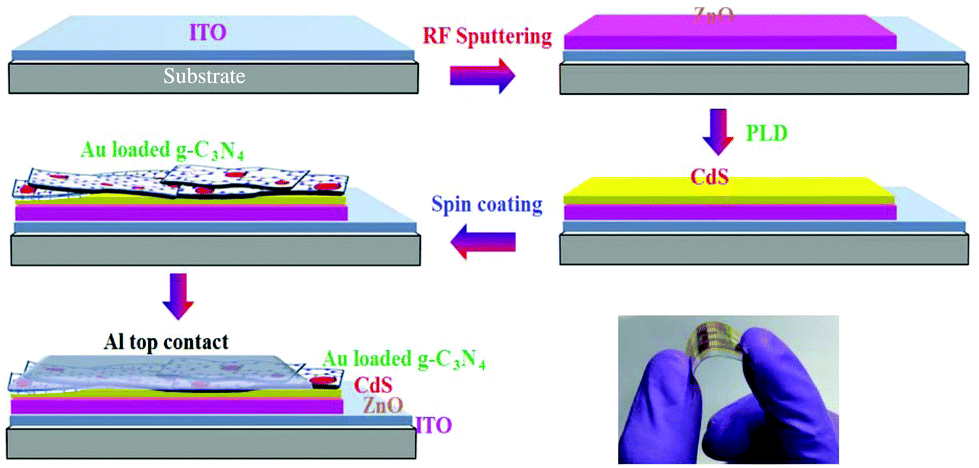II-VI semiconductors for multifunctional applications
Wide bandgap II-VI semiconductors (ZnO, CdS, ZnS) with their unique optical properties in the visible spectrum offer great potential for optoelectronic and photovoltaic devices. We work on developing high performances solar cells, photodetectors, photo-transistors using ZnO, CdS nanostructures and their heterostructures. We also study the plasmonic effect in the optical properties of these materials by introducing novel metal nanoparticles (Au, Ag). With collaboration, interesting results on bio-integrable optoelectronics, gas sensing and memory devices have been done by introducing silk protein with Au nanoparticles and ZnO. ZnO nanorods grown on patterened substrates (using soft lithography) are being utilized for photo-transistors, LEDs and gas sensing applications.
2D Nanosheet/ZnO Heterojunctions for White-Light Emission
The existence of these two types of domains in BxCyNz nanosheets bestows a fascinating electronic structure originating from the π, π*, n states of g-C3N4 and the native defect states of h-BN. Like conventional B-doped g-C3N4, p-type conductivity has been perceived upon the incorporation of C into the h-BN lattice. The ternary nanosheets exhibit unique negative thermal quenching (NTQ) characteristics in photoluminescence emission, making the material stupendous for the fabrication of superior-performance light-emitting diodes using a lower injection current density at room temperature.
-Pal, S et al. “Boron Carbonitride Nanosheet/ZnO Nanorod Heterojunctions for White-Light Emission” in ACSanm (2021). DOI: 10.1021/acsanm.1c02133

Piezo-phototronic effect in ZnO/perovskite heterojunction
Utilizing the superior luminescence properties and high color purity of inorganic perovskite nanocrystals (NCs), we report the fabrication of color-saturated CsPbBr3−xIx (x = 0–3)/ZnO heterojunctions based white light emitting diodes (LEDs) on a flexible platform. Here, bandgap engineered mixed halide perovskite NCs have been prepared by solution phase synthesis technique that was spin coated on sputtered ZnO film, acting as an electron injector layer as well as an efficient luminescent material.
-Pal, S et al. “Strain mediated light emission using heterojunctions of all-inorganic mixed-halide perovskite nanocrystals via piezo-phototronic effect” in Nano Energy (2021). DOI: 10.1016/j.nanoen.2021.106200


Piezo-phototronic effect in SnO nanosheet/ZnO nanorod hybrid
We have demonstrated the piezo-phototronic effect-induced enhancement in photoconductive response in the visible region under self-bias conditions utilizing SnO nanosheet/ZnO nanorod-based bulk heterojunction devices. The hybrid heterojunction has been found to respond under an external mechanical stimulus, which is originated by the piezoelectric effect of the c-axis-oriented ZnO nanorods
-Pal, S et al. “Superior Performance Self-Powered Photodetectors Utilizing the Piezo-Phototronic Effect in SnO Nanosheet/ZnO Nanorod Hybrid Heterojunctions” in ACSaem (2020). DOI: 10.1021/acsaelm.0c00275

Plasmonic nanocomposite: understanding of charge transfer in Au-ZnO
Understanding the charge transfer dynamics at the interface of metals and semiconductors has received much attention in efficient plasmonic induced photonic devices. Here, we present ultrafast charge transfer dynamics in Au–ZnO nanocomposite systems by exciting them in interband and intraband levels of Au with pump energies higher (2.48 eV) and lower (1.96 eV) than the threshold energy for interband transition (2.4 eV), using the femtosecond time-resolved pump-probe technique. The transfer of highly energetic hot electrons from Au nanoparticles to ZnO across the Schottky barrier results in an accessible optical response for wide bandgap ZnO in the visible to infrared range via plasmon charge collection.
-Gogurla, N et al. “Plasmon charge transfer dynamics in layered Au–ZnO nanocomposites” in JAP (2020). DOI: 10.1063/1.5134892

Light trapping mediated gas sensing by ZnO nanostructure
An ordered array of 1D ZnO nanorods obtained by colloidal templating is shown to dramatically enhance the sensing response of NOx at room temperature by confining light and creating periodic structures. The sensitivity is measured for a concentration varying from 2 to 10 ppm (response 53% at 10 ppm) at room temperature under white light illumination with ≈225 nm hole diameter. The decoration of ZnO Nanorods with gold nanoparticles shows enhanced sensor performance (response 130% at 10 ppm) due to localized surface plasmon resonance under white light illumination.
-Chakrabarty, P et al. “Light Trapping-Mediated Room-Temperature Gas Sensing by Ordered ZnO Nano Structures Decorated with Plasmonic Au Nanoparticles” in ACSomega (2019). DOI: 10.1021/acsomega.9b01116

Understading of charge separation in Au-C3N4/ZnO
We report on the events of Förster resonance energy transfer (FRET) and direct transfer (DT) of electrons in two-dimensional graphitic carbon nitride (g-C3N4) nanosheets-based plasmonic hybrid heterojunctions of Ag–C3N4/ZnO. The occurrence of FRET has been understood from the quenching of emission and lowering of luminescence decay time of the hybrid samples. The attachment of zinc oxide (ZnO) nanorods with the hybrid nanosheets has led to an efficient charge separation due to the formation of type II band alignment.
-Bayan, S et al. “Förster Resonance Energy Transfer Mediated Charge Separation in Plasmonic 2D/1D Hybrid Heterojunctions of Ag–C3N4/ZnO for Enhanced Photodetection” in ACSanm (2019). DOI: 10.1021/acsanm.9b00705

Piezo-phototronic mediated enhanced photodetection in Au-C3N4/ZnO
We have studied the piezo-phototronic induced enhancement in the photo-response of CdS/ZnO heterojunctions attached with plasmonic Au nanoparticle loaded 2D-graphitic carbon nitride (g-C3N4). The hybrid g-C3N4/CdS/ZnO heterojunction favours the charge carrier separation through the formation of a step-like band alignment. The improved piezo-phototronic properties originated from the plasmonic properties of Au loaded g-C3N4 and the piezoelectric characteristics of c-axis oriented ZnO films may be used for future flexible photonic devices.
-Pal, S et al. “Piezo-phototronic mediated enhanced photodetection characteristics of plasmonic Au-g-C3N4/CdS/ZnO based hybrid heterojunctions on a flexible platform” in Nanoscale (2018). DOI: 10.1039/C8NR07091A


